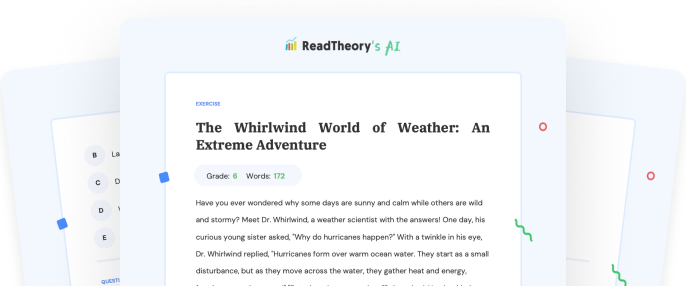Transform Your Teaching
with AI-Powered Worksheets
With ReadTheory’s Instant Worksheet Builder, you can create engaging, grade-appropriate worksheets tailored to your students in minutes. Spark curiosity, save time, and empower critical thinking with AI-powered tools designed for teachers like you.


Shakespearean Sonnets: The Melody of Iambic Pentameter and Timeless Themes
The Bard of Avon, William Shakespeare, is renowned not only for his plays but also for his poetic prowess, particularly his sonnets. A Shakespearean sonnet, distinct in structure and style, consists of 14 lines divided into three quatrains (four-line stanzas) and a couplet. The quatrains often present an argument or idea, while the couplet usually offers a concluding insight or twist. Unlike his contemporaries, who used sonnets merely to celebrate idealized love, Shakespeare employed this form to explore a wide array of deeply personal themes. His sonnets delve into the complexities of love and beauty, the relentless march of time, and the inevitability of mortality. The sonnets are written predominantly in a meter called iambic pentameter, a rhythm of speech that mimics the human heartbeat. This beat gives life to his sonnets and makes them sound pleasing to the ear. Take, for example, Sonnet 18, Shall I compare thee to a summer s day? Each line in this sonnet perfectly adheres to the iambic pentameter, creating a rhythmic pulse as you read it. Despite being written over 400 years ago, Shakespeare s sonnets maintain their relevance today. Their universal themes resonate with readers of all ages, making them timeless pieces of literary art. As you read them, you re not just reading words; you re experiencing the beat of humanity that Shakespeare so elegantly encapsulated in his sonnets.
Question 1
What is unique about the structure of a Shakespearean sonnet?
It consists of 20 lines divided into five quatrains
It consists of 16 lines divided into four quatrains
It has no specific structure
It consists of 14 lines divided into three quatrains and a couplet
It consists of 10 lines divided into two quatrains and a couplet
Question 2
What is iambic pentameter?
A five-line stanza in poetry
A type of rhyme scheme
A rhythm of speech that mimics the human heartbeat
A type of poetic imagery
A form of poetic license
Question 3
Unlike his contemporaries, what did Shakespeare use sonnets for?
To celebrate idealized love
To explore a wide array of deeply personal themes
To write about his family
To comment on political issues of his time
To describe the beauty of nature
Question 4
What are some of the themes Shakespeare delves into in his sonnets?
The complexities of love and beauty, the relentless march of time, and the inevitability of mortality
The beauty of nature and the power of the elements
The struggles of the lower classes and the corruption of the nobility
The exploration of the universe and the mysteries of life
The joys of childhood and the challenges of adolescence
Question 5
Why do Shakespeare s sonnets maintain their relevance today?
Because they are required reading in schools
Because they are written in modern English
Because their universal themes resonate with readers of all ages
Because they contain historical information about Shakespeare s time
Because they are written in a popular poetic form
 or share via
or share via

Assign the ReadTheory pretest to determine students' reading levels.

Why Teachers Love
Instant Worksheet Builder?

Tailored Content for Every Student
Craft worksheets with passages and multiple-choice questions customized to your chosen topic and grade level, ensuring relevance and engagement.

Save Hours
of Prep Time
Our AI, Lexi, generates complete worksheets—passages, questions, and answers—in minutes, freeing you to focus on teaching, not planning.

Standards-Aligned Learning
Every worksheet is designed to boost reading comprehension and critical thinking, aligning seamlessly with State Standards to help your students shine.
Personalized teaching
for personalized learning
Browse worksheets created and refined by educators using Lexi—your source for inspiration and ready-to-use resources.


ReadTheory is free for Teachers to use.
Join thousands of educators using ReadTheory for free. Sign up today and start creating in just minutes!





